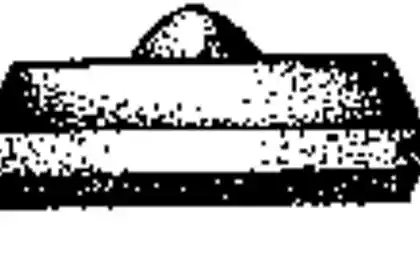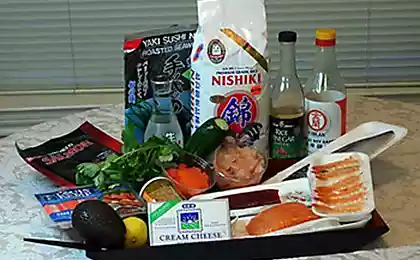516
The rule of three thirds — Breakfast in Japanese
Where? Where are you going? And Breakfast? Everything is on the table.
— Then go to Breakfast.
— When then?
— In the evening!
She was right, my grandmother, overlapping me the way to retreat from the kitchen, saying:
— Breakfast — the Foundation on which you build your day. You know: "eat Breakfast yourself, share dinner with a friend, dinner give to the enemy.
Bobrikovskiy the first ten years of my life, I started to live at grandma's covenants.
However with a little correction: the enemies of the dinner is not to give. Getting spoiled and do not fall behind.

In 2013 UNESCO has awarded Japanese cuisine Washoku cultural heritage status. Surprisingly, this is not done before, it is no accident that this nation holds the palm for longevity.
I just need to find out their secrets because I have so much planned that in seventy years not to meet, fulfilling.
First things first. Where we build our day.
What is a typical traditional Breakfast in Japan? Well, of course, rice and fish. The rich, and so happy. Figure in a Japanese family is always there. Often hot in Suihanki is a rice cooker, which the Japanese invented in the forties of the last century and now spread around the world under the name slow Cooker. Or in a ceramic pot with two lids Do-nabe. Cooked without oil and salt. Not very sticky, but not crumbly. Served in a special Cup for rice — Chawan.

Unlike Korea, where it is considered bad form, a bowl of rice in Japan decided to take in hand, capturing the rice with chopsticks, sometimes sprinkled with Furikake — dried or salted seaweed, vegetables, sesame seeds, fish or krill. Therefore, a bowl of rice is always placed on the left.
I admire coherent system that combines the ergonomics of Japanese dishes, the rules for placing it on the table and traditional style of its use. Everything happens for a reason and everything has an explanation.
Japanese Breakfast differs from Breakfast other national cuisines that one meals serves a balanced mix of several dishes — Tei-shoku, each of which made use of separately. They are like instruments in an orchestra create harmony together.
The main rule is: One to three is Ichi ji san sai. That is, to one Cup of rice should be submitted three additional meals. One main (usually the protein source ) and two vegetable.
The second pillar, which holds a traditional Breakfast is Yaki-zakana — fish baked on the grill.
Grill fitted all manufactured in Japan gas stoves, so occupies an important place in the diet of the Japanese Yaki-zakana prepared without a drop of oil.
Seasonality is strictly observed. Every month brings your sort of fish. Today is Saira. In contrast, harvested in summer or spring, it is now just filled with amber fish oil. Fins fish traditionally rubbed with salt.
The aesthetics of serving food on the table has its norms. One of them, save the fins, head and tail intact. This indicates the freshness of the fish ( although everything we eat, usually caught within two to three days ) and pleases the eye with natural beauty.

The skin is not cracked, leaving unsightly torn the rift, its cruciform incision. First fried side, when an to be exposed, then that will be hidden from the eyes of the consumer.
Whole fish always floats right to left, is served his nose to the bowl of rice, back from the consumer. So it visually looks better, in addition, the rules of table manners require eating fish sticks, left to right. It is easier to do, beginning with the head.
Most often accompaniment to baked fish is served grated on a very fine grater Japanese radish Daikon. The juice is carefully pressed, forming a neat mound that is located at the tail of the fish. The top of Redkino slides drizzled with soy sauce.
The third constant component of the Breakfast is Miso soup. It is prepared as quickly as possible. As much as you need to boil water, because the ingredients are chopped concise and cooking takes no more than two minutes.

Very often, the lack of salt in the rice balanced by pickled, salted or pickled vegetables — Tsuke-mono, which are always in the refrigerator of a Japanese housewife. But the volume does not exceed the size of two thimbles.

A frequent guest on the table during Breakfast are soy products. This can be a delicate soy cheese Tofu or fermented beans, Natto, quiet horror any foreigner who recognize that to the table served sticky rotten beans, which are impossible to convey to the mouth, not prepackages reaching for sticks sticky threads.

Approximate weekly menu from the repertoire of a working mother.
To prepare each Breakfast took no more than 15 minutes.
Option # 1
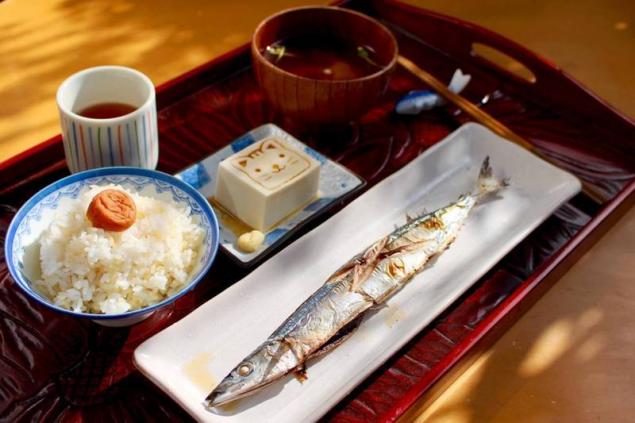
Option # 2
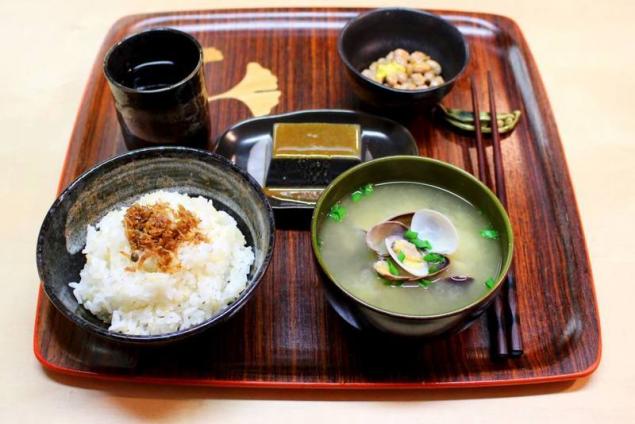
Option # 3
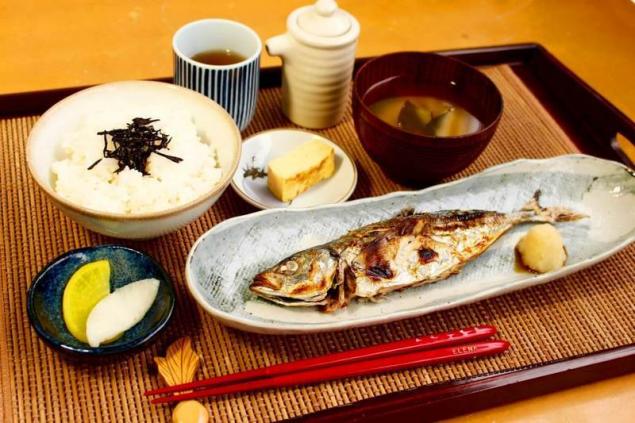
Option # 4

Option # 5
Ocha-zuke — speed version of the Breakfast, when not even five minutes to cook.
Rice, topped with a mixture of dried vegetables, fish flakes, filled with green tea, with the addition of dried seaweed and fish paste Kamaboko.
Usually served in the evening, after a hearty meal and a serious alcoholic libations, to mitigate the harmful for the body effects.
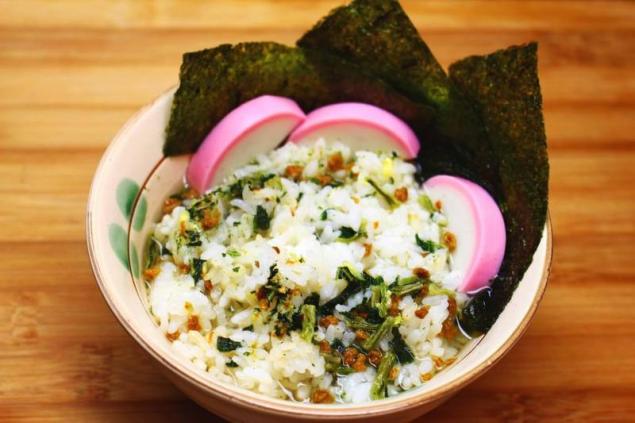
Also interesting: What to replace the potatoes
How to cook — to boil or fry?
But the main art of the Japanese Breakfast is to enough to walk to work, leaving the dishes, all these "one plus three" plates multiplied by the number of consumers, that most consumers.published
Author: Elena Arasan
Source: zagran.me/2015/12/05/japanesebreakfast/
— Then go to Breakfast.
— When then?
— In the evening!
She was right, my grandmother, overlapping me the way to retreat from the kitchen, saying:
— Breakfast — the Foundation on which you build your day. You know: "eat Breakfast yourself, share dinner with a friend, dinner give to the enemy.
Bobrikovskiy the first ten years of my life, I started to live at grandma's covenants.
However with a little correction: the enemies of the dinner is not to give. Getting spoiled and do not fall behind.

In 2013 UNESCO has awarded Japanese cuisine Washoku cultural heritage status. Surprisingly, this is not done before, it is no accident that this nation holds the palm for longevity.
I just need to find out their secrets because I have so much planned that in seventy years not to meet, fulfilling.
First things first. Where we build our day.
What is a typical traditional Breakfast in Japan? Well, of course, rice and fish. The rich, and so happy. Figure in a Japanese family is always there. Often hot in Suihanki is a rice cooker, which the Japanese invented in the forties of the last century and now spread around the world under the name slow Cooker. Or in a ceramic pot with two lids Do-nabe. Cooked without oil and salt. Not very sticky, but not crumbly. Served in a special Cup for rice — Chawan.

Unlike Korea, where it is considered bad form, a bowl of rice in Japan decided to take in hand, capturing the rice with chopsticks, sometimes sprinkled with Furikake — dried or salted seaweed, vegetables, sesame seeds, fish or krill. Therefore, a bowl of rice is always placed on the left.
I admire coherent system that combines the ergonomics of Japanese dishes, the rules for placing it on the table and traditional style of its use. Everything happens for a reason and everything has an explanation.
Japanese Breakfast differs from Breakfast other national cuisines that one meals serves a balanced mix of several dishes — Tei-shoku, each of which made use of separately. They are like instruments in an orchestra create harmony together.
The main rule is: One to three is Ichi ji san sai. That is, to one Cup of rice should be submitted three additional meals. One main (usually the protein source ) and two vegetable.
The second pillar, which holds a traditional Breakfast is Yaki-zakana — fish baked on the grill.
Grill fitted all manufactured in Japan gas stoves, so occupies an important place in the diet of the Japanese Yaki-zakana prepared without a drop of oil.
Seasonality is strictly observed. Every month brings your sort of fish. Today is Saira. In contrast, harvested in summer or spring, it is now just filled with amber fish oil. Fins fish traditionally rubbed with salt.
The aesthetics of serving food on the table has its norms. One of them, save the fins, head and tail intact. This indicates the freshness of the fish ( although everything we eat, usually caught within two to three days ) and pleases the eye with natural beauty.

The skin is not cracked, leaving unsightly torn the rift, its cruciform incision. First fried side, when an to be exposed, then that will be hidden from the eyes of the consumer.
Whole fish always floats right to left, is served his nose to the bowl of rice, back from the consumer. So it visually looks better, in addition, the rules of table manners require eating fish sticks, left to right. It is easier to do, beginning with the head.
Most often accompaniment to baked fish is served grated on a very fine grater Japanese radish Daikon. The juice is carefully pressed, forming a neat mound that is located at the tail of the fish. The top of Redkino slides drizzled with soy sauce.
The third constant component of the Breakfast is Miso soup. It is prepared as quickly as possible. As much as you need to boil water, because the ingredients are chopped concise and cooking takes no more than two minutes.

Very often, the lack of salt in the rice balanced by pickled, salted or pickled vegetables — Tsuke-mono, which are always in the refrigerator of a Japanese housewife. But the volume does not exceed the size of two thimbles.

A frequent guest on the table during Breakfast are soy products. This can be a delicate soy cheese Tofu or fermented beans, Natto, quiet horror any foreigner who recognize that to the table served sticky rotten beans, which are impossible to convey to the mouth, not prepackages reaching for sticks sticky threads.

Approximate weekly menu from the repertoire of a working mother.
To prepare each Breakfast took no more than 15 minutes.
Option # 1
- Rice with Ume-boshi — pickled green apricots,
- Miso soup with mushrooms,
- Saury,
- Tofu with ginger and soy sauce.

Option # 2
- Rice sprinkled with dried fish and shrimp
- Miso soup with river shells Asari and green onions
- Tofu made from sesame seeds and powder of the roots of plants Kuchu,
- Fermented soybeans Natto,
- The barley tea.

Option # 3
- Rice with Hijiki seaweed,
- Pickled daikon radish
- Miso soup with Wakame seaweed and tofu
- Grilled mackerel,
- A piece of Japanese omelette, Tamago-Yaki.

Option # 4
- Pic of this year's harvest, brewed with the "gifts of the season" with carrots, bamboo, mushrooms, Lotus roots, product of tubers of amorphophalus, spinach and chestnuts,
- Miso soup with seaweed, green onion and dried gluten
- Chum salmon baked with green pepper and onions Bliss,
- Cucumbers, marinated in the juice of the Perilla, ginger and pepper,
- Hanpen is the product of a mixture of a shark's flesh, a mountain of potatoes and egg whites with sprouts of daikon radish.

Option # 5
Ocha-zuke — speed version of the Breakfast, when not even five minutes to cook.
Rice, topped with a mixture of dried vegetables, fish flakes, filled with green tea, with the addition of dried seaweed and fish paste Kamaboko.
Usually served in the evening, after a hearty meal and a serious alcoholic libations, to mitigate the harmful for the body effects.

Also interesting: What to replace the potatoes
How to cook — to boil or fry?
But the main art of the Japanese Breakfast is to enough to walk to work, leaving the dishes, all these "one plus three" plates multiplied by the number of consumers, that most consumers.published
Author: Elena Arasan
Source: zagran.me/2015/12/05/japanesebreakfast/

